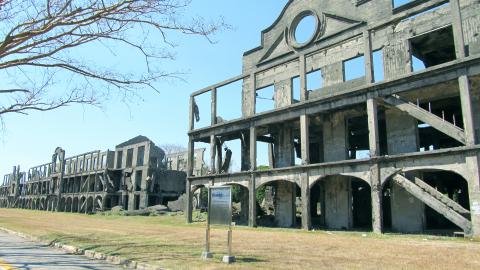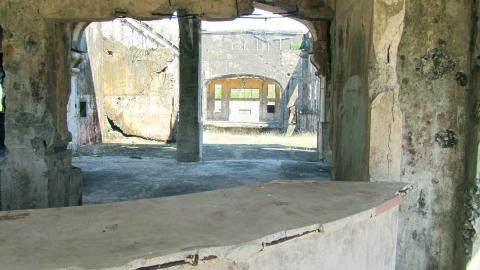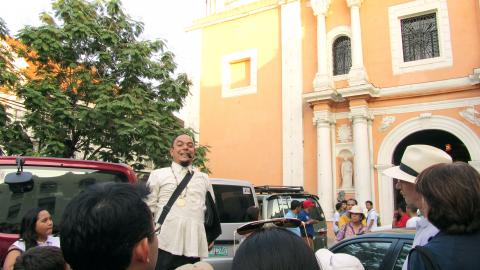A city that was largely destroyed during World War II might not seem like the most promising of destinations for anyone with an interest in history, but the fusion of indigenous, Spanish, Chinese and US cultures in Manila has created a capital unlike any other in Asia.
The old heart of Manila, Intramuros, preserves some of the Spanish colonial influence that dominated the Philippines for nearly 350 years until the Americans arrived on the scene at the end of the 19th century. Visit it while you can because in October a Global Heritage Fund report titled Saving Our Vanishing Heritage identified Intramuros as one of 12 sites worldwide “on the verge” of irreparable loss and destruction.
Perhaps its most interesting feature is Fort Santiago, where Philippine national hero Jose Rizal was imprisoned before his execution by the Spaniards in 1896. Despite the horrors of its dungeons and the sad tale behind the brass footsteps that retrace Rizal’s final walk to face a firing squad, today the fort and its environs provide an island of tranquility in a city that has more than its share of noise, pollution and crumbling infrastructure.

PHOTO: TONY PHILLIPS, TAIPEI TIMES
Nearby, Rizal Park is one of the few green open spaces in the city and is home to the Rizal Monument.
A great way to get a handle on how Manila has evolved over the years is to go on the “If These Walls Could Talk!” walking tour of Intramuros with renowned guide Carlos Celdran. However, the term “walking tour” doesn’t really do justice to an experience that is part performance and part historical lecture, with costume, music, a horse-drawn calesa ride and a surprise Philippine snack all thrown in.
The tour begins outside Fort Santiago with Celdran explaining that, to the Spaniards, the Philippines was a backwater. It had no gold, unlike Spain’s Latin American colonies, and was initially nothing more than a province of the colony of Mexico, thousands of kilometers away.

PHOTO: TONY PHILLIPS, TAIPEI TIMES
However, Celdran points out that it would be a mistake to think that Manila’s history began with the arrival of the Spaniards in 1571. There was already a considerable settlement on the site but its buildings were made of wood, leaving no trace today.
Its population was Muslim and the Spaniards nailed their colors to the mast when they named the fort built to protect their settlement Santiago, after St James the Moor-slayer (Santiago Matamoros), a carving of whom is on the large gateway outside the fort.
Celdran points out the irony of the fact that the last Moorish kingdom in the Iberian Peninsula was only conquered in 1492, so when the Spaniards pitched up in the Philippines they must have been somewhat perturbed to have sailed half way around the world only to find themselves confronted by yet more Muslims.

PHOTO: TONY PHILLIPS, TAIPEI TIMES
After going inside the fort and then visiting a particularly impressive section of imposing city walls built by the Spaniards — where Celdran explains how the Hispanophile atheist Rizal is an unlikely national hero in the deeply Catholic Philippines — the next stop is a statue of US General Douglas MacArthur and World War II-era Philippine president Manuel Quezon.
Celdran, complete with general’s hat, sunglasses and pipe in imitation of MacArthur, then proceeds to dissect the American’s reputation, contending that Manila’s destruction in 1945, which left few traces of the splendor of what was christened the “Pearl of the Orient” in pre-war days, was largely a result of MacArthur’s egotism.
There was no overriding military reason to capture the city, but having famously declared “I shall return” after departing the Philippines in 1942 as Japanese forces closed in, the general was not to be denied. Thousands of civilians died at the hands of the Japanese and as a result of “collateral damage” from US bombing and shelling. According to Celdran, the fierce fighting saw the city suffer more destruction than any other allied city in World War II with the exception of Warsaw.

PHOTO: TONY PHILLIPS, TAIPEI TIMES
Next on the itinerary is the church of San Agustin, the only one of the seven churches in the walled city to escape the carnage of 1945 intact. Celdran points out that this is no ordinary church, thanks to the four Chinese lions outside it, another example of the cultural synthesis so typical of the Philippines.
The last part of the tour focuses on the important Chinese contribution to Philippine life and the comparative lack of European input to the nation’s genetic mix. This was in stark contrast to the situation in Spain’s Latin American colonies and resulted from the overwhelmingly church-driven nature of Spanish rule in the Philippines. However, Celdran points out that not all clerics were true to their vows of celibacy, including one of his ancestors.
The tour ends with a culinary example of the melting pot that has given rise to Philippine culture, with bowls of halo halo, or shaved ice topped with such diverse items as boiled kidney beans, sugar palm fruit, coconut, plantains, chickpeas, gelatin, jackfruit, tapioca and sweet potato.
A short boat-ride away from the city lies one of the world’s most extensive and best-preserved World War II sites, the island of Corregidor in Manila Bay.
A US fortress, it was captured by the Japanese and recaptured by the Americans. After World War II, the Philippine government preserved it largely as it was, as kind of a vast memorial and shrine.
The only practical way to get to the island is on an organized tour with Sun Cruises, which despite having a monopoly provides a pretty good deal, incorporating the return boat trip, transport around the island in a guided tour bus, and a decent buffet lunch that includes typical Philippine dishes.
There are many impressive sites on the island including numerous gun batteries, a tunnel complex and the Filipino Heroes Memorial. The bus makes numerous stops allowing visitors to wander around the sites and take pictures.
For sheer scale the bombed-out Topside Barracks is hard to beat. Also known as Mile-Long Barracks, its real length is 400m, but that still reputedly makes it the world’s longest barracks. The vast three-story structure is still mostly standing despite the fierce pounding it received during the war.
The Pacific War Memorial is nearby, as is a small museum and the very recognizable remains of a cinema, albeit minus its roof and seats.
Another highlight is a statue of a waving MacArthur at the site of the small dock where he boarded a boat to make his escape just before the final surrender of US forces on Corregidor in 1942.
Manila is not as well-blessed with museums as some cities but the Museum of the Filipino People is worth a visit, especially for information on the pre-Spanish period, which is not covered at the sites already mentioned. It contains the anthropology and archaeology divisions of the National Museum of the Philippines and is conveniently located right next to Intramuros. More information can be found at www.nationalmuseum.gov.ph.
Manila is by no stretch of the imagination one of Asia’s most attractive cities. There is striking poverty, the traffic can be horrendous and many of the roads and buildings have seen better days. However, the flip-side is that people are invariably good-natured and hospitable, language barriers are not a problem because of the ubiquitous use of English and the food is a delicious mix of East and West.
It may no longer be the “Pearl of the Orient” but its unique sights help make it a genuine rough diamond.
IF YOU GO
Getting there
* China Airlines, EVA Air, Philippine Airlines and Cebu Pacific all fly to Manila Ninoy Aquino International Airport from Taiwan Taoyuan International Airport. Journey time is about two hours. A cab from the airport to the city center takes about 30 minutes but traffic can be unpredictable.
Getting around
* Manila has a metro system but it is not extensive. Taxis are inexpensive, but make sure the driver turns on the meter. Buses or jeepneys (elaborately decorated half-bus, half-jeep) are the other alternatives but be warned, the city suffers from major traffic congestion.
Currency
* You may have trouble exchanging any currency other than US dollars in many places in Manila. At press time NT$1 = 1.49 Philippine pesos, US$1 = 43 pesos.
Tours
* For information on the “If These Walls Could Talk!” walking tour visit: celdrantours.blogspot.com. The cost is 1,000 pesos (US$23). Celdran also offers the “Living la Vida Imelda!” tour, concentrating on the Philippines in the 1970s.
* Ivan Mandy also offers well-regarded walking tours, including one of Chinatown. See oldmanilawalks.com for more details.
* A trip to Corregidor can be booked for 1,999 pesos through Sun Cruises at www.corregidorphilippines.com.

Behind a car repair business on a nondescript Thai street are the cherished pets of a rising TikTok animal influencer: two lions and a 200-kilogram lion-tiger hybrid called “Big George.” Lion ownership is legal in Thailand, and Tharnuwarht Plengkemratch is an enthusiastic advocate, posting updates on his feline companions to nearly three million followers. “They’re playful and affectionate, just like dogs or cats,” he said from inside their cage complex at his home in the northern city of Chiang Mai. Thailand’s captive lion population has exploded in recent years, with nearly 500 registered in zoos, breeding farms, petting cafes and homes. Experts warn the

No one saw it coming. Everyone — including the Chinese Nationalist Party (KMT) — expected at least some of the recall campaigns against 24 of its lawmakers and Hsinchu Mayor Ann Kao (高虹安) to succeed. Underground gamblers reportedly expected between five and eight lawmakers to lose their jobs. All of this analysis made sense, but contained a fatal flaw. The record of the recall campaigns, the collapse of the KMT-led recalls, and polling data all pointed to enthusiastic high turnout in support of the recall campaigns, and that those against the recalls were unenthusiastic and far less likely to vote. That

The unexpected collapse of the recall campaigns is being viewed through many lenses, most of them skewed and self-absorbed. The international media unsurprisingly focuses on what they perceive as the message that Taiwanese voters were sending in the failure of the mass recall, especially to China, the US and to friendly Western nations. This made some sense prior to early last month. One of the main arguments used by recall campaigners for recalling Chinese Nationalist Party (KMT) lawmakers was that they were too pro-China, and by extension not to be trusted with defending the nation. Also by extension, that argument could be

Aug. 4 to Aug. 10 When Coca-Cola finally pushed its way into Taiwan’s market in 1968, it allegedly vowed to wipe out its major domestic rival Hey Song within five years. But Hey Song, which began as a manual operation in a family cow shed in 1925, had proven its resilience, surviving numerous setbacks — including the loss of autonomy and nearly all its assets due to the Japanese colonial government’s wartime economic policy. By the 1960s, Hey Song had risen to the top of Taiwan’s beverage industry. This success was driven not only by president Chang Wen-chi’s